|
|

|
|
The following article first appeared in the November-December 2001 issue of Ad Astra. It is reprinted here with permission.
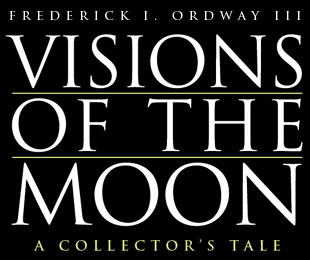 All reproductions from the Frederick Ordway collection.
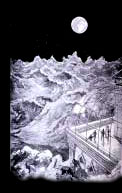 I was a mere lad when I came under the spell of the Moon, and I can still remember wondering if it would ever be visited. Years later, I discovered among my parents' papers a note I'd written several weeks before my 11th birthday. In it, I reminded them that what I most wanted was Roy Rockwood's juvenile novel Lost on the Moon. They complied, and I still have that very special birthday present. I was a mere lad when I came under the spell of the Moon, and I can still remember wondering if it would ever be visited. Years later, I discovered among my parents' papers a note I'd written several weeks before my 11th birthday. In it, I reminded them that what I most wanted was Roy Rockwood's juvenile novel Lost on the Moon. They complied, and I still have that very special birthday present.
Inspired by it and other books in the Rockwood "Great Marvel Series" - Through Space to Mars, One a Torn Away World, By Air Express to Venus - I began to take a more serious look around me. What was going on that might make space travel a reality? Within a year or so, I learned about the American Rocket Society, and by the time I was 13 had become a student member. Its publication Astronautics led me to some popular nonfiction books on rocketry and space flight which I quickly bought and read.
At about the same time, I came across my first pulp science fiction magazine, Amazing Stories, and it wasn't long before I was collecting back issues of it and others of the genre, occasionally trading duplicates with fellow fans. Travel to the Moon and planets being staples in those days, my enthusiasm must have become apparent to those around me. It is not surprising then that the editor of my high school yearbook listed some perceived talents and priorities: ". . . chemistry tops in school . . . hobby-women . . . practical joker . . . plans on rocketing to the moon . . .".
I continued searching and acquiring pulps over the years and built up a respectable collection, many with stunning cover and interior illustrations. But it was books on the Moon and planets that fascinated me most. My search for them took me to second-hand and antiquarian book dealers in the United States, Europe, Australia, New Zealand, and South America. During two trips to Asia and one to Africa, I never turned up anything relevant to space flight.
As my search intensified, some coveted books found their way onto my bookshelves. Their titles alone fascinated me: Tremblett Carter's The People of the Moon (1895), H. G. Wells' The First Men in the Moon (1901), Mark Wicks' To Mars via the Moon (1911), Otis Adelbert Kline's Maza of the Moon (1930), and Ray Cummings' Brigands of the Moon (1931). With these in hand, the time had come to look for earlier and presumably more costly titles, most of which I would discover during the 1950s and 1960s in antiquarian bookstores and occasionally at auction.
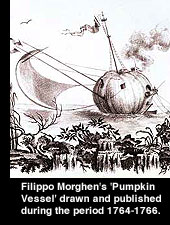 Seventeenth and eighteenth century discoveries include my most treasured work, bought at action in London in the mid-1960s, Bishop John Wilkins' nonfiction The Discovery of a World in the Moon; or, A Discourse tending, to prove, that 'tis probable there may be another habitable World in that Planet (1638). I'd always wanted to obtain a work of fiction by another English bishop, Francis Goodwin, that happened to have been published that very same year. His The Man in the Moon: or a Discourse of a Voyage thither being extremely rare and costly, the best I could do was come across a stunning, limited facsimile edition in original tan sheep gilt that was published by the Albion Press in London in 1969. Seventeenth and eighteenth century discoveries include my most treasured work, bought at action in London in the mid-1960s, Bishop John Wilkins' nonfiction The Discovery of a World in the Moon; or, A Discourse tending, to prove, that 'tis probable there may be another habitable World in that Planet (1638). I'd always wanted to obtain a work of fiction by another English bishop, Francis Goodwin, that happened to have been published that very same year. His The Man in the Moon: or a Discourse of a Voyage thither being extremely rare and costly, the best I could do was come across a stunning, limited facsimile edition in original tan sheep gilt that was published by the Albion Press in London in 1969.
In Paris and London I found several editions of works by Cyrano de Bergerac in the original French as well as the first complete translation, The Comical History of the States and Empires of the Worlds of the Moon and Sun...newly Englished by A. Lovell, A.M. (1687). Other interesting finds were Daniel Defoe's The Consolidator; or, Memories of Sundry Transactions from the World of the Moon, translated from the Lunar Language (1705); Samuel Brunt's (pseudonym) A Voyage to Cacklogallinia (1727); Murtagh McDermot's (also pseudonymous) A Trip to the Moon...containing Some observations, made by him during his Stay in that Planet, upon the Manners of the Inhabitants (1728); and Cornelie Wouters, Baronne de Wasse's rarely cited Le Char Volant; ou, Voyage dans la lune (The Flying Chariot or Trip to the Moon (1783). I also located a play whose action takes place on the Moon, Aphra Behn's The Emperor of the Moon: A Farce As it is Acted by Their Majesties Servants, at the Queens Theatre (1687).
Two lunar theme publishing events dominated the nineteenth century, one occurring during the first third and the other during the final. In 1835, what was called the "Moon Hoax" unfolded at the expense of gullible readers of New York City's Sun newspaper. In a series of articles, Richard Adams Locke purported to reveal all manner of structures and creatures discovered on the Moon by British astronomer Sir John Herschel, who at the time was conducting observations near the Cape of Good Hope in South Africa. These articles were reprinted in pamphlet form in 1852 as The Celebrated Moon Story, which always eluded me, and seven years later as a book, The Moon Hoax; or, a Discovery that the Moon has a Vast Population of Human Beings, which I eventually acquired.
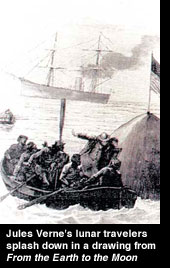 The nineteenth century's second seminal event was the publication of the two now famous lunar tales of Jules Verne, De la terre à lune: Trajet direct en 97 heures 20 minutes (From the Earth to the Moon, first published in 1865), and its sequel Autour de la lune (Around the Moon, first published in 1870). I had as a matter of course read the books in translation as a boy, but I wanted the real thing - the earliest examples of the original French editions that I could find (I already knew that the first editions would probably be beyond my reach). The nineteenth century's second seminal event was the publication of the two now famous lunar tales of Jules Verne, De la terre à lune: Trajet direct en 97 heures 20 minutes (From the Earth to the Moon, first published in 1865), and its sequel Autour de la lune (Around the Moon, first published in 1870). I had as a matter of course read the books in translation as a boy, but I wanted the real thing - the earliest examples of the original French editions that I could find (I already knew that the first editions would probably be beyond my reach).
I did quite well, turning up quite a few copies of each book and of an edition that combined the two novels under one cover. The Librairie Bonaparte in Paris was a good but not the only source; I had luck at other bookstores in Paris and elsewhere in France as well as New York and London. I was fortunate to secure at auction the first Hetzel illustrated edition of De la terre à la lune with 41 images and a map by artist De Montaut. Equally gratifying was to stumble, in the autumn of 1938, upon the first English language edition entitled From the Earth to the Moon Direct in 97 Hours 20 Minutes: and a Trip Round It (1873) at a little bookstore in Hay-on-Wye, Gloustershire, England. It was translated by Louis Mercier and Eleanor E. King.
Many derivative stories appeared in the aftermath of Jules Verne and I'll mention a couple. Of particular interest is Georges Le Faure and Henry de Graffigny's three-volume Aventures extraordinaires d'un savant russe (Extraordinary Adventures of a Russian Scientist, 1889-91). The first was concerned with the Moon, the second with the Sun and the small inner planets, and the third with the giant outer planets and comets. Each volume was profusely illustrated and prefaced by astronomer Camille Flammarion. At one time or another, I found copies in France, Spain and Portugal - I subsequently traded off duplicates. A fourth volume, released by a different publisher as Les mondes stellaires (Stellar Worlds) is virtually unobtainable. I have never seen a copy and know of only vague references to it.
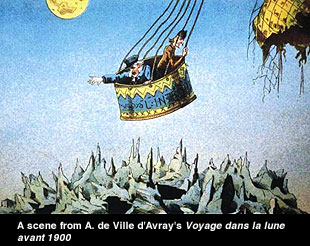
The second example I'll cite is A. de Ville d'Avray's Voyage dans la lune avant 1900 (Travel to the Moon Before 1900). The book is undated but library research in France revealed it to have been published in Paris in 1892. Written primarily for children, it features a chromolithographed title and 50 delightful interior color illustrations depicting a dream balloon trip to and on the Moon. The book appears to be very rare; not even the Biblioth�que Nationale in Paris has a copy. A search of book catalogues there leads me to believe that Voyage is the author's only book. I know nothing else about him.
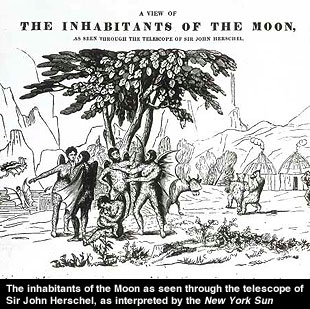
While looking for books about the Moon, I by no means limited myself to works of fiction; I quite naturally wanted to know what astronomers had learned about it. Among my most important early acquisitions were James Nasmyth and James Carpenter's The Moon; Considered as a Planet, a World, and a Satellite (1874), Edmund Neison's The Moon and the Conditions and Configures of its Surface (1876), and several editions of Richard A. Proctor's The Orbs Around Us (1886) and Other Worlds than Ours (1872, 1882, 1896). Incidentally, I ran across the 1882 edition in the David Thomas Rare Bookshop in Auckland, New Zealand, in 1980 - an example of my far-flung collecting endeavors.
As my collection of books and magazines grew, I began to reproduce photographically the many images contained therein. At the same time, I was always on the lookout for maps and prints and am especially proud of my 4-by-5-inch glass-enclosed transparencies of lunar drawings made by astronomers between the seventeenth and nineteenth centuries.
|

© 2022 collectSPACE.com All rights reserved.
Questions? E-mail [email protected]
|
|

|
Frederick I Ordway III is an educator, consultant, researcher, and author on space flight and energy programs. From 1960-64 he was Chief of Space Information Systems at NASA Marshall Space Flight Center, working in association with Werner von Braun. In 1968-69, he was hired as a consultant by Stanley Kubrick at MGM for 2001: A Space Odyssey. A former Director of the National Space Institute and the National Space Society, Ordway currently serves on the NSS Board of Governors.
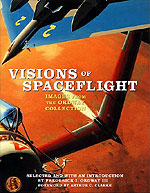
Visions of Space Flight, published in September 2001, opens Ordway's massive collection of space-inspired art to the reader. It is available in bookstores, by calling 800-788-3123 or by clicking on the book cover above.
|

|
